British Royal Wedding Outfits | 1920 to 2018
April 04, 2018 The history of royal weddings in Britain is rich in luxurious celebrations and extravagant ceremonies, with detailed records stretching back to the times of Queen Victoria. As two new royal weddings are on the horizon later in 2018, we take a look back at the royal weddings since 1920 and the dresses that made them so influential to modern brides today. Could Meghan Markle and Princess Eugenie of York be influenced by these previous royal weddings?
26 April 1923: The wedding of HRH The Duke of York (King George VI) to Lady Elizabeth Bowes-Lyon (Queen Elizabeth) at Westminster Abbey
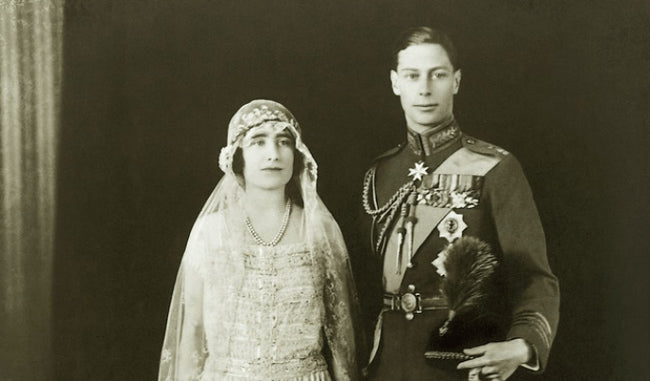
Picture source: Royal Central
It took three different proposals for the then Lady Elizabeth Bowes-Lyon to leave behind her Scottish roots and marry King George VI. As the second in line to the throne, Prince Albert was dressed in full RAF uniform according to his rank. Many traditions for royal brides were started by Queen Elizabeth, including the long skirt on her dress which was not the trend of the 1920s and led to a few critics calling her otherwise highly fashionable wedding dress ‘medieval’. During the 1920s, flapper dresses were the height of fashion and were generally just below the knee, with low waist lines and decorations that flattened the bust line. Queen Elizabeth’s wedding dress - with the exception of the length - was highly fashionable with a dropped waist and relatively shapeless cut with comparison to current styles. The pearl, silver thread embellishments across the loose bodice were typical of the period, along with the veil she wore low over her brow. This style of veil was designed to emulate the look of the extremely fashionable cloche hats of the time that were responsible for the short bob cut hairstyle also typical of the period and worn by The Queen Mother at her wedding.
Another tradition started by by this couple was holding the wedding ceremony itself at Westminster Abbey. Before their wedding, all previous royal weddings had been private affairs held in royal chapels, however the royal couple’s wedding was used to uplift the spirits of the nation after the First World War, with the new Duchess of York laying her bouquet at the Tomb of the Unknown Warrior to remember her own brothers - a tradition now followed by all royal brides who marry in Westminster Abbey.
June 3, 1937: Prince Edward (King Edward VIII) married Bessie Wallis Warfield Simpson at Château de Candé, France
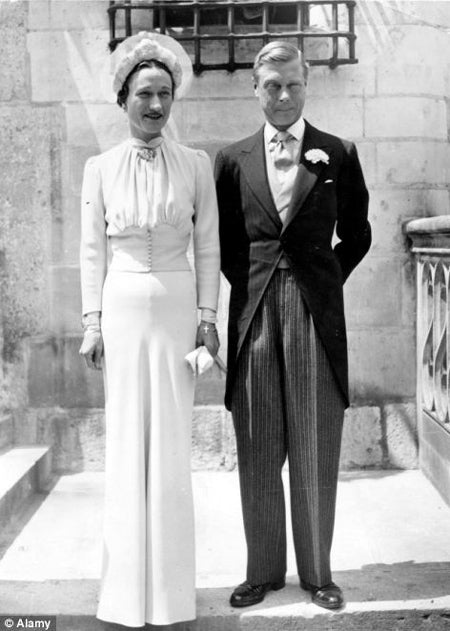
Picture source: Daily Mail
One of the lesser known kings of England since the 1900s, possibly since his reign lasted for less than a year, King Edward VIII’s marriage to Wallis Simpson caused a constitutional crisis. At the time of the then Prince Edward’s expression of his desire to Mrs Simpson, she had already been divorced once and was attempting a second. Due to Edward’s position as the head of the Church of England, the law at the time did not permit him to marry a divorcee who’s ex-partner was still alive. Because of his love for Mrs Simpson, a mere few months after she divorced her second husband, HRH King Edward VIII abdicated the throne and they were wed at a chateau in France with only five friends reported as present at the time of the nuptials. Following the wedding, they were given the titles of HRH Duke of Windsor and Her Grace Duchess of Windsor by King George VI.
For their highly controversial wedding, the then Mrs Simpson wore a tightly fitted, floor length gown that accentuates her slim figure. Known for her fashion forward looks, the Duchess of Windsor had her dress designed by Mainbocher, a fashion house that was in its early years in Paris before it grew in popularity and spread to New York. the dress was certainly different from other dresses of the time, featuring a cinched waist, high collar and was in the colour Wallis Blue that matched her eyes.
20 November 1947: Princess Elizabeth (now Queen Elizabeth II) and Lieutenant Philip Mountbatten (formerly Prince Philip of Greece and Denmark, now Prince Philip, Duke of Edinburgh) were married at Westminster Abbey

Picture sources in order: Town and Country and Telegraph
Having fallen in love when Princess Elizabeth was only thirteen and on a tour of the Britannia Royal Naval College (BRNC Dartmouth) with her parents and sister, the then Prince Philip of Greece and Denmark escorted the two sisters around his college during their visit. For the next seven years, the two exchanged letters until Prince Philip asked King George VI for his daughter’s hand in marriage. The two became officially engaged three months after the Queen’s twenty first birthday and Prince Philip abandoned his royal titles, taking on his mother’s family name and became a British subject in order to marry the Queen. Since their marriage in 1947, their marriage is the longest in British history, celebrating their 70th (platinum) wedding anniversary in 2017.
For the big day in 1947, the young Princess Elizabeth paid for her dress in ration coupons, some contributed from the general public added to the 200 granted by the government to purchase the material needed to create her beautiful duchesse dress. Designed by Norman Hartnell, the same man who later designed the Queen’s coronation gown, and created from satin, the wedding dress and train were embroidered with thousands of crystal beads and 10,000 seed pearls that formed garlands of orange blossoms, star lilies and white York roses. The silhouette of the dress was a particular favourite of the Queen as she requested a similar design for her coronation gown.
6 May 1960: The wedding of Princess Margaret and Antony Armstrong-Jones (Earl of Snowdon)
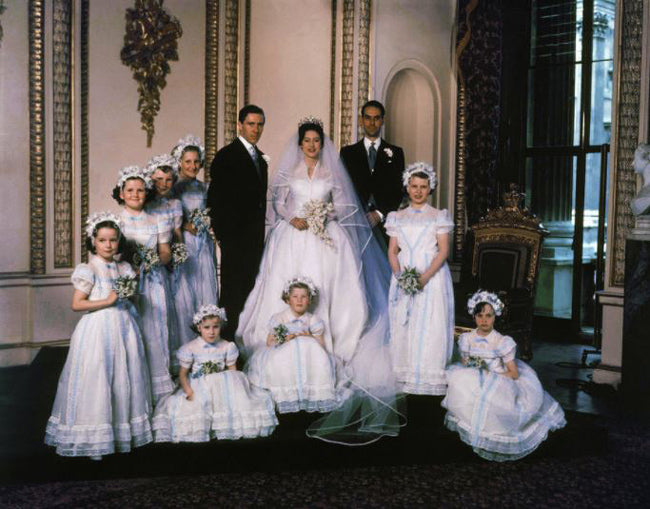
Picture source: Flickr
The wedding of Princess Margaret and Antony Armstrong-Jones was the first royal wedding to be televised and it was estimated that over twenty million people tuned in to watch the ceremony. Princess Margaret’s wedding dress was also designed by Norman Hartnell, however was completely different from her sister’s decorative gown. Opting for volume over embellishments, the princess’ silk organza wedding dress had over thirty metres of fabric in the skirt alone. Typical of the period, the delicately rimmed veil worn by Princess Margaret was bouffant and her bouquet was smaller than that of previous royal brides.
14 November 1973: Princess Anne and Captain Mark Phillips were wed at Westminster Abbey

Picture source: Zimbio
Both Olympic contestants and with a shared love of horses, Princess Anne and Captain Mark Phillips were married six months after their engagement was announced in 1973. Princess Anne was only twenty two at the time of the wedding, and had her nine year old younger brother - Prince Edward - as pageboy. The ceremony was watched by over 500 million people worldwide and was held at Westminster Abbey with around 2,000 guests present. Leading the style for wedding dresses in the seventies, Princess Anne’s medieval style high collared gown with long Todor sleeves set the trend for wedding dresses of the next ten years, with many women copying sleeve styles from different periods in history to make their dress unique. Captain Phillips wore the uniform of his regiment, the Queen’s Dragoon Guards, standing out as a stark contrast to his bride’s embroidered white dress in scarlet red.
29 July 1981: The wedding of Prince Charles and Diana Spencer at St Paul’s Cathedral
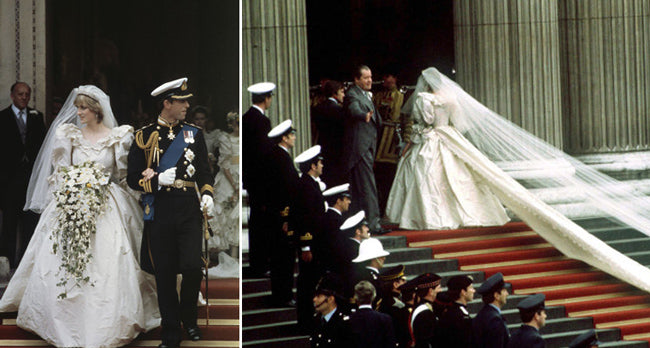
Picture sources in order: Good Housekeeping & Huffington Post
Arguably one of the most memorable of all royal British weddings, the wedding of Prince Charles and Diana Spencer was watched by an estimated 750 million international TV viewers and 3,500 members of the congregation at St Paul’s Cathedral. The couple were well loved by the public, and Lady Diana Spencer was known for her fashionable outfits - something that did not change in her choice of wedding dress. Designed by David and Elizabeth Emanuel, the dress was one of the most closely guarded secrets on the run up to the wedding, with the then Princess of Wales commissioning a second, back-up dress should the designs of the first be leaked before the big day. Now as one of the most famous dresses in the world, Lady Diana herself selected the designers and worked closely with them on the gown. The iconic dress was made from ivory silk taffeta and antique hand-made lace featuring in the train that had once belonged to Queen Mary. The train itself was 25 feet long (7.62m) and was the final dramatic aspect of the gown as it was revealed as Diana arrived at the Cathedral. The puffed sleeves, full skirt and ruffle accents set the trend for brides of the time, and still to this day brides take inspiration from Lady Diana’s iconic wedding dress.
23 July 1986: The wedding of Prince Andrew, Duke of York and Sarah Ferguson at Westminster Abbey

Picture source: Order of Splendour
Having known each other since childhood, Prince Andrew and Sarah Ferguson’s marriage took place at Westminster Abbey, only four months after the engagement. Watched by a TV audience of 500 million and 2,000 guests at the abbey, the wedding was an extravagant affair with over 30,000 flowers filling the venue. The former Duchess of York’s wedding gown took the fashionable style of the period, as inspired by Lady Diana Spencer, and made it appropriate for the more common woman. Still maintaining the long train - 17 ft. long - and big sleeves, the wedding dress designed by Lindka Cierach formed a more achievable fashion for wedding dresses of the late eighties and early nineties.
12 December 1992: The wedding of Princess Anne and Tim Laurence at Crathie Kirk, Balmoral, Scotland
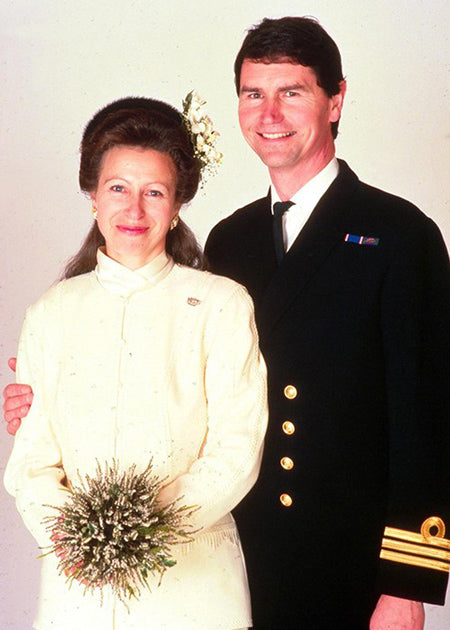
Picture source: Unofficial Royalty
The second marriage of Princess Anne was a small and private affair with only 30 close friends and family present at the intimate ceremony held at Crathie Kirk, the place of worship for the royals while at their summer residence in Balmoral Castle. Timothy Lawrence was an Equerry to the Queen and met Princess Anne trough his time at the palace. The two exchanged letters and once the Princess Royal had divorced her first husband, the two became engaged and were married a week after their engagement was officially confirmed by a spokesperson for the Palace. As the wedding itself was a small and private affair, Princess Anne was dressed in a relatively simple knee length white suit dress with delicate embroidered patterns that matched her earrings. Her small bouquet of white heather was appropriate for the small, Scottish wedding and was complimented nicely by her floral headpiece.
19 June 1999: The Wedding of Prince Edward, Earl of Wessex and Miss Sophie Rhys-Jones (now Countess of Wessex)
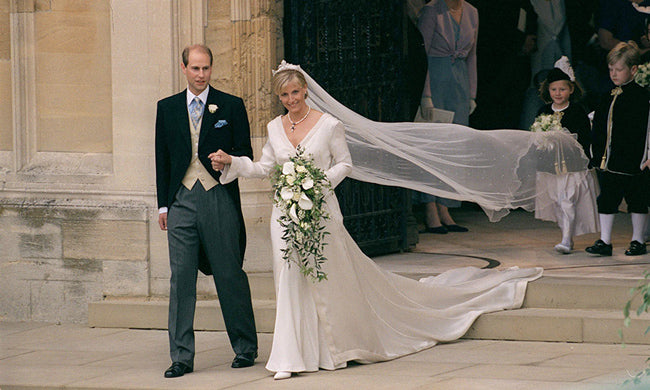
Picture source: Hello Magazine
Meeting due to a mutual love of tennis, Prince Edward and the then Miss Sophie Rhys-Jones were married at St George’s Chapel at Windsor Castle in front of around 550 guests. The ceremony was a relatively small affair, with the couple stating their preference that their wedding was not to be a state occasion; as such, there was no balcony wave and all ladies attending were requested to wear long, evening dresses and not to wear hats, with all but the Queen Mother adhering to this dresscode.
The Countess of Wessex’s dress was created from hand-dyed silk organza and silk crepe and was designed by Samantha Shaw. Consisting of a long sleeved coat and fitted dress beneath, the outfit was adorned with over 325,000 pearls and crystals, arranged in rows along the cuffs and down the corset. The veil was only an inch longer than the moderate train and was also hand decorated with crystals. The earrings and necklace worn by the Countess of Wessex were designed by her husband, as was her engagement ring that was the most expensive royal engagement ring at the time. The unique diamond tiara had never been seen before and was lent by the Queen from her personal collection.
9 April 2005: The Wedding of Prince Charles, Prince of Wales and Camilla Parker Bowles (now Duchess of Cornwall)
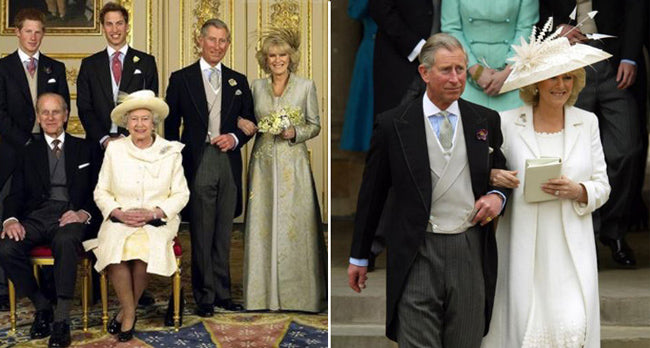
Picture sources in order: British Royal Family Blog and Daily Mail (as before)
Prince Charles’ second marriage was to Ms Camilla Parker Bowles, the couple had known each other for a long period of time having met in 1971 as part of the same social circle. The pair split when Prince Charles went abroad to serve in the Royal Navy and Camilla was engaged to and married her first husband Andrew Parker Bowles. Prince Charles returned to the UK and married his first wife Lady Diana Spencer, however, both couples divorced and the former lovers reunited. The civil ceremony took place at Windsor Guildhall while the blessing was held slightly later in the day at St George’s Chapel.
The Duchess had two outfits for her big day, opting to wear white to the civil ceremony and a beautiful teal and gold combination to the blessing. Her first outfit was a plain white dress with circular discs at the bottom of the skirt, ending just below the knee. She teamed this with a collared white coat of equal length and matching purse; to solve the issue of a tiara, Camilla wore a large white hat to the civil ceremony and gold headpiece that matched her daughter’ to the blessing. Her second outfit was elegant and flattering with a light blue silk chiffon dress under a matching floor length oyster silk blue coat with delicate gold decoration and embroidery around the neckline. Her small bouquet of white and yellow flowers finished the look.
May 17, 2008: Peter Phillips (son of Princess Anne) married Autumn Kelly at St George's Chapel, Windsor Castle
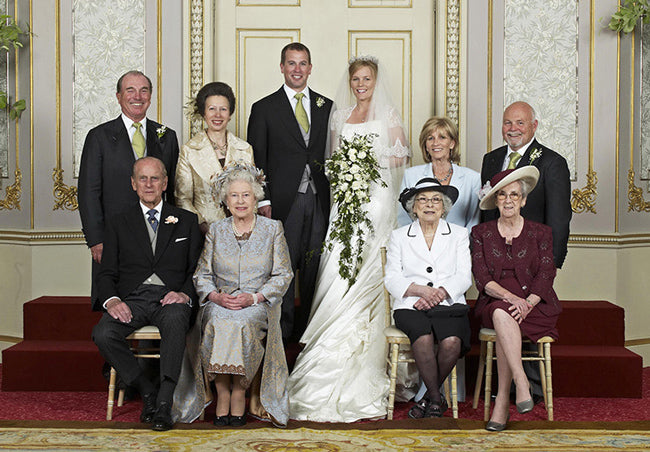
Picture source: Hello Magazine (as before)
As the first of Queen Elizabeth II’s grandchildren to tie the knot, Peter Phillips’s marriage to Autumn Kelly was not televised, but rather was covered by Hello! Magazine that evoked mixed feelings from the general public and has not been permitted by the Queen since. Wearing a gown designed by Sassi Holford, Miss Kelly had asked for her dress not to draw too much attention - resulting in a relatively plain, white Italian duchesse satin. As a strapless dress is not in keeping with royal fashion, a small beaded bolero made of delicate Chantilly lace was added to make the outfit appropriate for the royal status of the wedding. The dress had a two yard long, A-line silk duchess skirt with a sash at the waist, Chantilly lace inserts and bows down the back. Her Swiss silk tulle veil also featured a border of the beaded Chantilly lace. The Festoon tiara worn by Autumn bas borrowed from Princess Anne and the pearl and diamond necklace and matching earrings set were sent to her the night before her wedding by the groom. The colour scheme for the wedding was white and pistachio green, with the bridesmaids dresses fitting perfectly in strapless floor length dresses by Vera Wang. The bouquet of Mrs Phillips was a relatively large cascade of white roses, spray roses, stephanotis and lily of the valley, while the bridesmaids carried small posies comprised of similar flowers.
April 29, 2011: Prince William, Duke of Cambridge (son of Prince Charles) married Catherine Middleton (now Duchess of Cambridge) at Westminster Abbey

Picture source: Telegraph (as before)
One of the most iconic British royal weddings of the twenty first century, the marriage of Prince William and Catherine Middleton was watched by over 35 million people worldwide and streamed online by an additional 70+ million. Meeting at St Andrews University in Scotland as coursemates, the second in line to the throne and his girlfriend became the focus of a lot of media attention, but following an official statement from the prince, they backed off and the couple reunited.
The iconic dress the world was waiting to see was revealed as the Duchess of Cambridge stepped out of the car as she arrived at Westminster Abbey. Designed by Sarah Burton for Alexander McQueen, the dress immediately changed the fashion for brides and long lace sleeves came back into fashion and have remained so since the royal wedding. The fashion-changing lace detailing on the sleeves, veil and dress of the Duchess was crafted from Chantilly lace and hand-embroidered flowers by the Royal School of Needlework. The dress was kept as such a secret that the designer denied any involvement before the wedding, and employees at the Royal School of Needlework were told that the dress was being created for a TV costume drama. The train of the dress was 2.7 metres long and was created from white satin gazar formed into pleats and the perfect weight to ensure it moved across the floor gracefully.
The bouquet carried by the new royal bride was home-grown and all of the flowers held particular meanings, including Lily of the valley for happiness, Sweet William for gallantry, Hyacinth for love and Myrtle for love and marriage. Interestingly, the Myrtle included in Kate’s bouquet was from a tree planted by Queen Victoria in 1845 giving it extra significance in the beautiful bouquet designed by Shane Connolly.
The jewellery worn by the then Miss Middleton was very simple but full of significance, like many of the details throughout the wedding celebrations. The tiara formed the bride’s ‘something borrowed’ as it was lent to her by the Queen, while the earrings were the ‘something new’ as a gift from her parents. Taking inspiration from the Middleton family tree, the earrings featured stylised diamond-set oak leaves and a pear shaped diamond set-drop with a pavé-set diamond acorn in it’s centre.
For the evening celebrations, the new bride changed into a reception dress that is said to have been the backup dress should the designs about the first have been leaked. Also designed by Sarah Burton for Alexander McQueen, the reception dress had the same silhouette as the first, however it was much more simple in design, featuring only a diamond waistline against the white satin of the gown. This she coupled with a delicate white fluffy stole and no additional accessories, proving that sometimes less truly is more.
July 30, 2011: Zara Phillips (daughter of Princess Anne) married Mike Tindall at the Canongate Kirk, Edinburgh

Picture source: Telegraph (as before)
As the second of Princess Anne’s children, Zara Phillips was the third of the Queen’s grandchildren to get married. Mrs Phillips chose to keep her maiden name due to her achievements as a world champion equestrian, rather than take her new husband’s last name. The couple met during the 2003 Rugby World Cup in Australia in Sydney and were wed in Edinburgh, the first royal wedding in Scotland for nearly 20 years.
The bride’s dress for her big day was designed by one of the Queen’s prefered couturiers, Stewart Parvin. Although not designed specifically for Zara Phillips, but rather tailored to her figure after it was purchased off-the-peg. The dress lacked the intricate designs of previous royal wedding outfits, with Mrs Phillips opting for a silk duchess satin and silk faille gown with a empire waist, chevron pleated bodice and tulle cap sleeves. The skirt of the dress was bell shaped with a large contrasting hemline that covered a pair of Jimmy Choo shoes. Zara kept her accessories to a minimum, borrowing her tiara and earrings from her mother, Princess Anne. the groom and groomsmen were all dressed in suits from Savile Row tailors Cad & the Dandy. The maid of honor wore another of Stewart Parvins’ designs, a knee length, dove grey dress made of duchess satin. The four bridesmaids wore dresses by local dressmaker Sue Palmer and the pageboy wore a Balmoral Tartan kilt.





















































